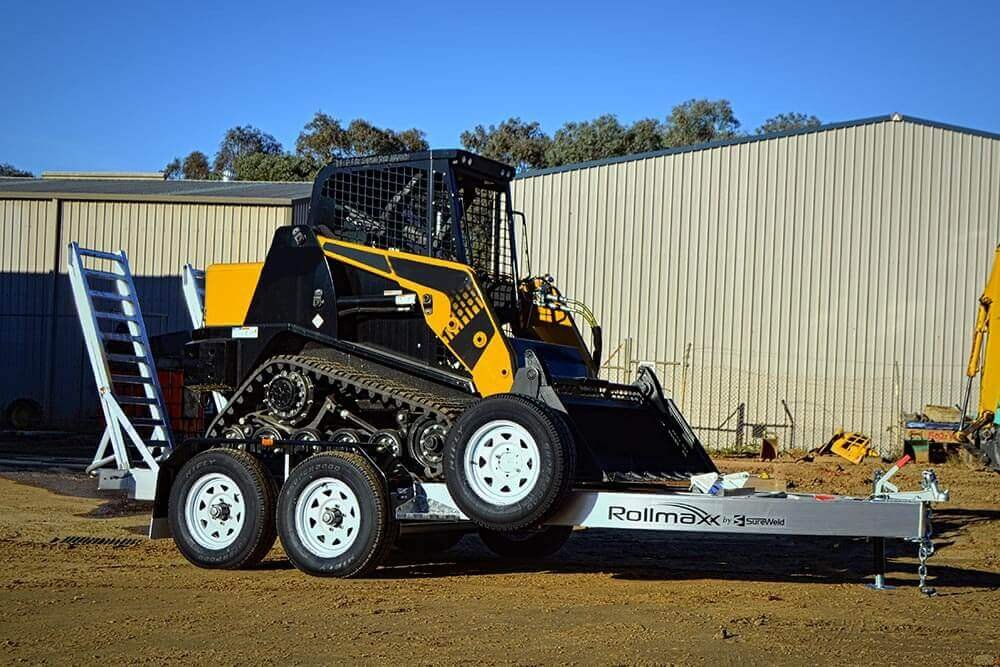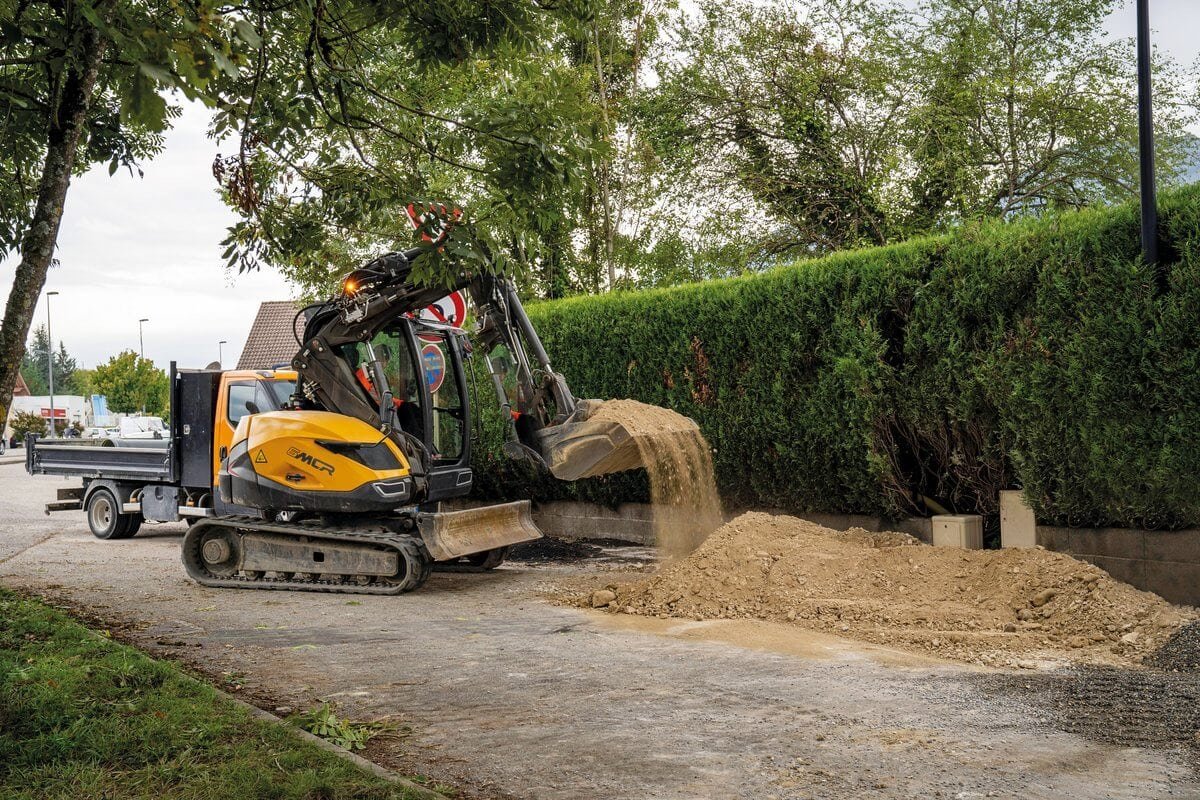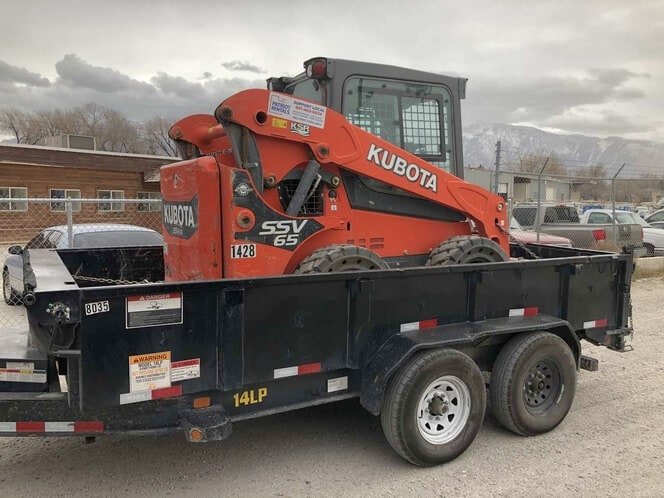Introduction
Do you want guidance on loading or transporting crawler skid steer loader? Safety should be your top priority. Whether you’re a construction professional or a DIY enthusiast, understanding the best practices for loading and transporting these powerful machines is crucial. In this blog, we will guide you through the essential steps to ensure crawler skid steer loaders’ safe loading and transportation.
We’ll cover everything from conducting pre-inspections and choosing the right loading equipment to securing the loader and following safe transport practices. Following these best practices can protect yourself, others, and your valuable equipment during loading and transporting crawler skid steer loader.

Preparing for Loading and Transporting Crawler Skid Steer Loader
Before loading and transporting your crawler skid steer loader, you must take the necessary steps to prepare for a safe journey.
Conducting a Pre-inspection of the Loader
Start by conducting a thorough pre-inspection of the loader to ensure it’s in optimal condition for transportation. Check for mechanical leaks, loose bolts, or worn-out components. Address these problems before proceeding to prevent potential accidents or damage during transit.
Additionally, ensure the loader has undergone regular maintenance, including oil changes, filter replacements, and overall servicing, to guarantee its peak performance.
Assessing the Loading and Transportation Equipment
Next, assess the loading and transportation equipment you’ll be using. Selecting the right trailers or trucks is crucial for safely transporting your crawler skid steer loader. Consider weight capacity, size compatibility, and stability when choosing the appropriate equipment. Ensure that the trailer or truck can accommodate the dimensions and weight of the loader safely.
Equally important is the use of proper tie-down equipment and restraints. The loader must be securely fastened to prevent shifting, tipping, or falling during transportation. Choose high-quality tie-down straps, chains, or binders designed to withstand the loader’s weight and provide sufficient strength. Remember to inspect these restraints for wear or damage and replace them if necessary.
Properly position and tension the tie-downs to ensure the loader remains stable throughout the journey.In addition to tie-downs, consider using additional measures to secure the loader, such as wheel chocks, braces, or blocks. These aids can enhance stability and prevent any movement or shifting during transit.
Double-check that all the necessary equipment and restraints are readily available and in good working condition before loading the crawler skid steer loader onto the transport vehicle.

Loading & Transporting Crawler Skid Steer Loader
Taking the right approach is crucial for a safe and successful operation when loading your crawler skid steer loader.
Choosing the Right Loading Equipment
Start by choosing the appropriate loading equipment. Select ramps or loading docks suitable for the loader’s size and weight. Ensure the ramps or docks have the necessary weight capacity and are in good condition to support the loader’s safe passage onto the transport vehicle.
If needed, use proper lifting equipment, such as cranes or forklifts, to facilitate the loading process. These tools can assist in smoothly and securely maneuvering the loader onto the transport vehicle.
Positioning the Loader for Loading
Once you have the loading equipment ready, it’s essential to position the loader correctly. Find a stable and level surface for the loader to ensure a solid foundation during loading. A stable surface minimizes the loader tipping or shifting risk during the process.
Take the time to carefully align the loader with the loading equipment. Ensure the loader is positioned correctly to facilitate a smooth and seamless transition from the ground to the transport vehicle.
Ensuring Proper Loading Techniques
Ensuring proper loading techniques is vital to maintain stability and balance. Distribute the weight evenly on the loader to prevent any imbalances that could lead to instability during transportation. Pay attention to the loader’s weight capacity and ensure it is not exceeded during loading. Additionally, secure any attachments and accessories properly.
This includes locking down buckets, forks, or other tools to prevent them from shifting or falling off during transportation.During loading, keep a close eye on the loader’s center of gravity. Be cautious of any potential instability caused by uneven weight distribution or improper positioning. Take your time and proceed with care to avoid accidents or damage to the loader or surrounding equipment.

Securing the Loader for Transportation
Securing your crawler skid steer loader properly for transportation is vital to ensure its safety and the safety of others on the road.
Understanding the Importance of Securing the Loader
Understanding the importance of securing the loader is the first step. A loose or improperly secured loader can lead to accidents, damage to the equipment, or even harm to other drivers. By correctly securing the loader, you minimize these risks and create a secure environment during transit.
Using Appropriate Tie-Down Methods
To secure the loader, it’s essential to use appropriate tie-down methods. Ratchet straps, chains, or binders are commonly used to fasten the loader to the transport vehicle. Ensure you have chosen high-quality tie-down equipment suitable for the loader’s weight and capacity.
Follow the manufacturer’s instructions for proper usage and placement of the tie-downs. Additionally, pay attention to the tension and angles of the tie-downs. The goal is to provide enough tension to keep the loader in place without putting excessive stress on the equipment.
Protecting the Loader During Transit
While securing the loader, it’s also important to protect vulnerable components. Covering windows, control panels, and other sensitive areas can help safeguard them from potential damage during transit.
Use protective materials such as tarps, blankets, or specialized covers to shield these components from road debris, dust, or inclement weather conditions. This additional layer of protection ensures that the loader arrives at its destination in optimal condition when loading & transporting crawler skid steer loader.

Loading & Transporting Crawler Skid Steer Loader: Safe Transport Practices
Ensuring safe transport practices for your crawler skid steer loader is crucial to protect yourself, others on the road, and the integrity of the equipment.
Obeying Traffic Regulations and Laws When Transporting Crawler Skid Steer Loader
One of the fundamental aspects of safe transport is obeying traffic regulations and laws. Adhere to posted speed limits and adjust your driving accordingly to accommodate the size and weight of the loaded vehicle.
Maintaining proper following distances is also essential. Give yourself ample space between your vehicle and the one in front to allow for safe braking and maneuvering in unexpected situations.
Monitoring the Loader When Transporting Crawler Skid Steer Loader
Monitoring the loader during transportation is another important practice to prioritize. Conduct periodic visual inspections while on the road to ensure the loader and its attachments remain secure and undamaged.
Look for any signs of shifting, loose components, or unusual vibrations that may indicate a problem. If you notice any issues, find a safe location to pull over and address them before continuing the journey when loading & transporting crawler skid steer loader.
Unloading the Crawler Skid Steer Loader
Following proper procedures is essential to ensure a safe and successful operation when unloading your crawler skid steer loader.
Choosing Appropriate Unloading Equipment
Start by choosing the appropriate unloading equipment. Identify suitable ramps or unloading docks that can accommodate the size and weight of the loader. Ensure the ramps or docks are in good condition and have the necessary weight capacity to support a smooth and secure unloading process.
Additionally, if needed, utilize proper lifting equipment such as cranes or forklifts to assist in unloading. These tools can facilitate the safe and controlled lowering of the loader from the transport vehicle when loading & transporting crawler skid steer loader.
Positioning the Loader for Unloading
Once you have the appropriate unloading equipment, it’s crucial to position the loader correctly. Find a stable and level surface for the loader to ensure a solid foundation during unloading. A stable surface minimizes the loader tipping or shifting risk during the process.
Take the time to align the loader with the unloading equipment. Hence, ensuring a smooth transition from the transport vehicle to the ground when loading & transporting crawler skid steer loader:.
Following Safe Loading & Transporting Crawler Skid Steer Loader Techniques
Following safe unloading techniques is paramount to maintain stability and prevent accidents. Gradually lower the loader, avoiding sudden or jerky movements that could lead to instability or damage. Use the appropriate controls or lifting mechanisms to control the descent of the loader carefully.
When Loading & Transporting Crawler Skid Steer Loader. Keep a close eye on the loader’s stability throughout the unloading process and make any necessary adjustments to ensure a safe and controlled operation. During unloading, be mindful of the loader’s center of gravity and distribute the weight evenly to maintain balance.
This helps prevent the loader from tipping or becoming unstable during unloading. Take your time and proceed cautiously to avoid accidents or damage to the loader or surrounding area when loading & transporting crawler skid steer loader.

Loading & Transporting Crawler Skid Steer Loader: Conclusion
Adhering to best practices for loading and transporting crawler skid steer loader is of utmost importance to ensure the safety of everyone involved. By conducting pre-inspections, choosing appropriate loading equipment, positioning the loader correctly, securing it with proper tie-downs, and following safe transport practices, you significantly reduce the risk of accidents, damage, and injuries.
Regular monitoring, periodic inspections, and careful unloading techniques ensure a safe and successful operation. Remember, safety should always be a priority, and by implementing these best practices, you can protect yourself, others, and your valuable crawler skid steer loader throughout the entire loading and transportation process.
Contact Us now for expert advise on loading and transporting your skid steer loader.


